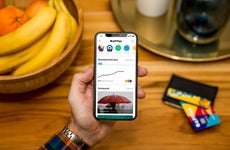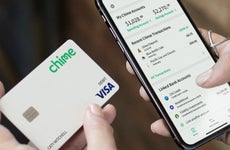5 mobile bank apps that help you save money

The Bankrate promise
At Bankrate we strive to help you make smarter financial decisions. While we adhere to strict , this post may contain references to products from our partners. Here's an explanation for .
Americans have struggled to build their savings over the past year. Only about a quarter (26 percent) have more savings than they did a year ago, while 49 percent have less savings compared to a year ago or none at all, according to Bankrate’s latest emergency savings report. To many, stashing away some money each month may seem like an impossibility.
One way to get started with building up savings is by using a money saving app. Several mobile banking apps come with features that help to make saving money easier and keep it a priority on consumers’ radars.
Whether you’re planning to start your savings from scratch or pad an emergency fund, these banking apps can aid in developing helpful savings habits.
Ally Bank Surprise Savings
The Surprise Savings feature offered by Ally Bank is a convenient option for consumers who want to save money effortlessly. The feature, part of the bank’s mobile app, analyzes a linked checking account to look for places where money can be saved and automatically transfers the funds to an Ally savings account that pays a competitive interest rate.
There are safeguards to prevent the Surprise Savings feature from making transfers of $100 or more and no more than three times a week. It will also alert you any time an automatic transfer is made. An Ally savings account is needed to use Surprise Savings, but it can be linked to any checking account.
Best for: Unexpected savings
Cost: Free
Available for: Android or iOS.
Huntington Bank Money Scout
Huntington Bank’s Money Scout is an automatic savings tool designed to help the regional bank’s customers figure out how much they can save.
The Money Scout tool analyzes customers’ spending habits, income and recurring expenses to determine how much money can be moved from checking to savings. When Money Scout finds money that’s not being used in checking, it transfers the amount ($5 to $50 ) into savings. The feature sends an alert each time a transfer is made, so that consumers can monitor their account balances for any overdraft risk and cancel the transfer before midnight that day if the funds are needed.
To use the Money Scout, both a checking and a savings account with Huntington are required. The bank offers a couple of interest-bearing checking accounts for a monthly fee, and it has one free checking account option that doesn’t earn interest. There are also ways to get the fees waived, such as by maintaining a minimum account balance.
Best for: Small transfers
Cost: Free. But a Huntington checking account and savings account are required to use the feature. Some fees may apply to manage these accounts.
Available for: Android or iOS.
USAA savings tools
USAA, a bank that serves military members and their relatives, offers several automatic savings options. A notable feature is the text savings tool, which analyzes consumers’ checking accounts to see if they can afford to automatically transfer $1 to $9 into savings every few days.
USAA sends a daily text with the amount available in your checking account, and if the amount falls below $100, no money is transferred into savings.
USAA reimburses up to $10 a month for out-of-network ATM fees, and USAA Classic Checking account holders can set up automatic transfers of those rebates into savings, up to $10 a month.
To take advantage of the savings tools, both a USAA Bank checking and savings account are required. Neither account charges monthly fees, and there’s no extra cost to use the savings tools.
Best for: Military members and veterans and their families
Cost: Free
Available for: Android or iOS.
Fifth Third Bank Smart Savings
Fifth Third Bank’s mobile Smart Savings tool makes automatic savings transfers for customers with a Fifth Third checking account and a Fifth Third Momentum Savings account.
Transfers are made each Tuesday and Thursday. Account holders can customize their automatic savings by setting limits on how much can be transferred each week.
In addition to Smart Savings, Momentum Savings account holders can also set up specific savings goals in the Fifth Third app — up to four at a time — and apply specified amounts of money to each goal.
A $5 monthly service fee applies to the Momentum Savings account, but it’s waived for customers who have any Fifth Third checking account (other than Express Banking) or when customers maintain an average monthly balance of $500.
Best for: Achieving specific goals
Cost: Free with a Fifth Third Momentum Savings account. A $5 monthly fee applies to the account, but it can be waived if criteria are met.
Available for: Android or iOS.
Varo Bank Save Your Pay
Varo Bank is an online-only, FDIC-insured bank that offers two automatic savings tools. The standout tool is called Save Your Pay. It’s useful for those who frequently receive direct deposit payments, as it allows you to designate a percentage of each direct deposit to be automatically transferred into a savings account.
Save Your Pay comes at no cost. It requires a Varo checking and savings account to use, but neither of these accounts charges a monthly fee. Save Your Pay can apply to any type of direct deposit, whether that be from an employer or from the government, and customers can set up automatic transfers for any percentage amount.
With a Varo Savings account, customers also have access to a Save Your Change feature, which rounds up the dollar amount on eligible transactions and transfers that change into the savings account.
Best for: Those who receive direct deposits
Cost: Free
What to watch out for
As you explore mobile app savings options, there are several precautions to keep in mind.
First and foremost, make sure the app is secure by using one that requires multifactor authentication, says Jacob Dayan, CEO of Community Tax, an accounting and tax advisory firm. “Multifactor authentication can be annoying, but this is one way to make sure no one will be hacking into your account,” he says.
When it comes to personal finances, it’s important to know how much of your income you can comfortably stash away. Though it’s possible to move as much money as you want into a savings account, there are limits on how often you can take money out of a savings account, says Lacy Rogers, the founder of financial advisory firm The Dedicated Dollar.
Another thing to watch out for is the risk of potential overdraft charges when there isn’t enough money in your checking account to cover spending.
“You’re better off setting up an alert to let you know if your balance gets too low rather than relying on overdraft protection,” Rogers says.
–Freelance writer Sarah Sharkey contributed to a previous version of this article.
Related Articles



